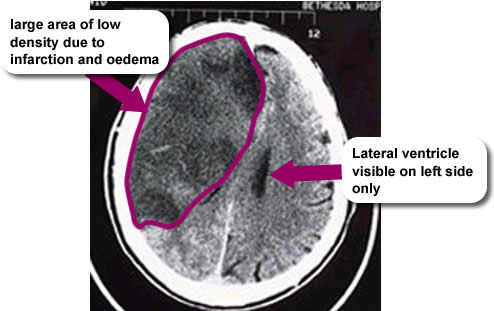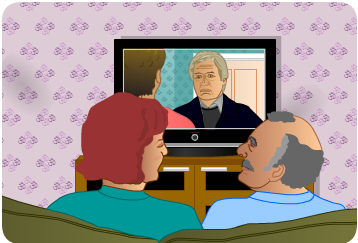Having checked for all the other potential causes for an decreased GCS it seemed likely that this was due to a further stroke and therefore a repeat CT was requested.
Maisie’s CT scan shows worsening cerebral oedema and the neurosurgeons advise that she is eligible for decompressive surgery.
What do you think these 2 scans show you?
Q. What other factors can cause decreasing levels of consciousness?
See view text alternative for more information on factors that can cause decreasing levels of consciousness.
You assess Maisie’s GCS and discover she is opening her eyes to pressure, that she is only making moan/groaning sounds and she’s withdrawing to pain (normal flexion) on the unaffected side.
Q. Please now score the GCS based on Maisie’s results:
Revisit our background information on the scale if you would like help with this task.
2 hours later whilst routinely checking the patients on the ward you notice that Maisie is lying slumped awkwardly in her bed.
Q. You go over to check on her, what should you do? Answer Yes or No to each question below.
On reassessment you realise that you previously assessed Maisie’s motor response on her affected (left) arm and therefore the score has dropped. GCS should always be performed on the side with the best motor response, usually the unaffected side. When you reassess Maisie’s motor response on her right arm, the score is now 6 instead of 1.
You are the nurse on nightshift and Maisie is one of your patients who is on 4 hourly observations. It’s time for her 2am observations. On completing her chart you notice that her GCS has changed since her last set of observations which were taken at 10pm.

There is an area of low density on the right hand side of the brain which is due to infarction and surrounding swelling (oedema). The degree of swelling is indicated by the squashing of the lateral ventricle which cannot be seen on the right side and displacement of the midline to the left. This pattern of infarction is consistent with a blockage of right the middle cerebral artery.

Maisie’s clinical symptoms include:
- Drowsiness
- Left sided hemiplegia
- Left sided sensory loss
- Left hemianopia
Her prognosis is not good.

Maisie is a 58 year old lady who was admitted to the Stroke Unit this everning at 7.50pm. Her husband reported noticing that Maisie’s mouth was drooping on the left side and that her speech was slurred when watching Coronation Street. Realising that something was seriously wrong he phoned for an ambulance.
Following her admission to hospital Maisie had a CT scan which confirmed she had a right MCA (Middle Cerebral Artery) infarct. She has a dense left sided weakness and is inconsistently awake and alert and other times drowsy and sleepy. Unfortunately, Maisie is not suitable for thrombolysis therapy.
The scale was originally developed for patients with Head injuries (HI), with typically more diffuse rather than focal neurological deficits.
In patients with aphasia the verbal score produces an unrepresentative assessment of their conscious level, therefore a totally aphasic patient would have a maximum score of 10 (rather than 15). This represents damage to the speech and language centre rather than decreased consciousness.
Identification of the best motor response is done by comparing the movements of each arm, therefore the non-hemiparetic limb should be used for assessing the motor response in the GCS. A painful stimulus must never be applied to a hemiplegic limb in patients who are awake and aware.
Factors that interfere with the assessment process in each category of the GCS. When interfering factors are present, the score should be recorded as ‘not testable’ (NT) for the relevant category of the GCS, e.g. if the patient has endotracheal tube, tracheostomy or swelling of eyes this should now be recorded NT (Not testable to record missing component). However, the overall trend demonstrated by the GCS within each of the 3 sections scores – eye opening, verbal response and motor response can inform clinical decisions and has clinical value.
Note: Click here for video link which provides a practical guide to carrying out and recording the 3 aspects of GCS assessment.





